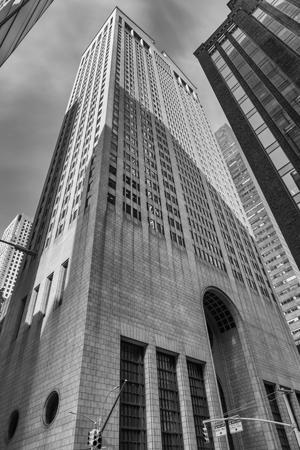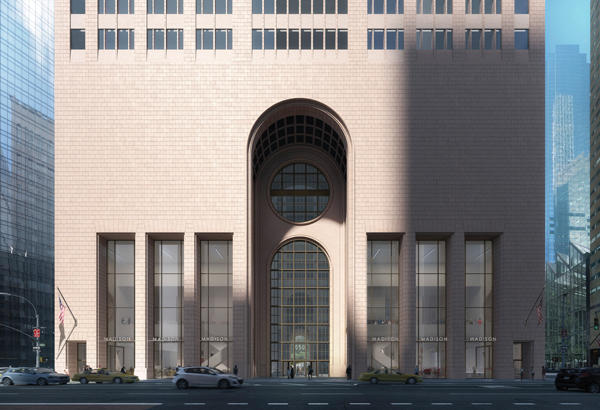Trending
 “Largest affordability crisis” in US: Miami-Dade is short 90K housing units
“Largest affordability crisis” in US: Miami-Dade is short 90K housing units ROVR lands $66M construction loan for 300-unit apartment project amid Miami River development boom
ROVR lands $66M construction loan for 300-unit apartment project amid Miami River development boom Vantage Capital pays $21M for 108-unit Hialeah rental complex amid investment sales slowdown
Vantage Capital pays $21M for 108-unit Hialeah rental complex amid investment sales slowdown Is the amenities craze coming to an end?
Is the amenities craze coming to an end?Behind 550 Madison’s messy makeover
How intense public backlash put the iconic tower on the landmarking fast track and forced a pricey design do over

Craig Edward Dykers drove from Austin, Texas, to Manhattan as an architecture student in 1985 to see an imposing, 37-story tower at 550 Madison Avenue that AT&T just had built for its headquarters.
Dykers made the more than one-day journey to view the latest work of Philip Johnson — the world-famous architect who had defined the ubiquitous glass and steel International Style decades earlier and was now taking a sharp left turn with the first postmodern skyscraper.
With its impenetrable granite facade, ornamental top resembling a Chippendale cabinet and grandiose lobby that some have compared to a church foyer, the building came as a big surprise to a city more accustomed to glass walls.
More than 30 years later, Dykers, who went on to start his own architecture firm, Snøhetta, was tapped to reimagine the same tower that captivated him as an aspiring architect. What followed in the fall of 2017, though, was a firestorm of criticism that turned the project into a public relations nightmare.
Dykers’ team came up with a dramatic design for the building’s new owners, Saudi Arabian conglomerate the Olayan Group and U.K.-based developer and asset manager Chelsfield. Olayan — which had purchased the iconic office tower from the Chetrit Group and Clipper Equity for a massive $1.4 billion in 2016 — proposed tearing out the rose Stony Creek granite at the building’s ground floor and replacing it with an undulating glass curtain wall.
“I don’t understand why they can’t maintain the exterior the way it was,” architect and professor Peter Eisenman told The Real Deal, adding that he found Dykers’ initial design “really offensive.”
Dykers said in a statement that “Philip Johnson’s approach to his work was often bold and mischievous” and noted that “the sculpted glass idea was created not only to bring much needed light into the building but also to create greater transparency to Madison Avenue.”
But while Snøhetta’s founder was looking to imprint his own bold vision on 550 Madison — which has been sitting vacant for about two years — many of his peers and other observers were not impressed. On the heels of a small but highly publicized protest, the Landmarks Preservation Commission swooped in to designate the building a landmark. Although that didn’t come fast enough to spare the building’s lobby, which was quietly dismantled to the shock of architects, preservationists and local officials, it did delay the $300 million makeover.

A rendering of the proposed redesign of 550 Madison in 2017
Snøhetta unveiled a new design in December 2018, showing most of the original facade intact — a huge overhaul to Dykers’ initial design — and the building’s owners are now hopeful the project is back on track. Despite lingering tensions, local officials seem poised to green-light the latest proposed changes to 550 Madison this month. A spokesperson for Landmarks Preservation, meanwhile, said the tower’s lobby was never under consideration for landmark status.
“This was death by a thousand cuts,” Layla Law-Gisiko, landmarks chair of Manhattan’s Community Board 5, said at a local committee meeting in December. “Whether you kill it a little more or a little less … it’s already done.”
Standing strong
Of course, it’s not uncommon for landlords to spring into action before their buildings are designated historical properties. The Dakota Stables at 342 Amsterdam Avenue, the Paterson Silks Building at 36 West 14th Street and the Screw Factory at 30 Great Jones Street were all demolished after being put on Landmarks Preservation’s calendar, for example.
Although 550 Madison lost its original lobby before being landmarked, the tower is notable for another reason: At just 33 years old in 2017, it barely qualified for landmarking, since all buildings considered must be older than three decades.
With 100-plus historical properties in the city, the tower was excluded from the priority list of buildings to be designated for protection ahead of the Midtown East rezoning in 2016. In the lead-up to the rezoning — which incentivizes tearing down and replacing older office buildings —Landmarks Preservation quickly approved 11 other properties.

The sudden fast-tracking to make 550 Madison a landmark one year later created a ripple effect beyond anyone’s expectations. In many ways, Olayan and Chelsfield’s retreat from their original proposal is a case study in how a cadre of political insiders and a methodical rebranding strategy can steer a redevelopment out of crisis.
About six months after the initial design was revealed, Olayan tapped RXR Realty, one of New York’s largest and most politically connected commercial landlords, to lead the tower’s redesign.
And the company executive appointed as the project’s new front man was none other than Seth Pinsky, best known in industry circles as the lead negotiator on such projects as Yankee Stadium and the new World Trade Center during his 10 years as the head of the city’s Economic Development Corporation.
Clipper Equity CEO David Bistricer, a former owner of the building, said that Snøhetta’s initial design “wasn’t done with the right spirit” and noted, in general, that it’s essential to try to understand how the public will react to a project before moving forward.
“If the developer’s tone deaf and doesn’t pay attention to how the community is going to perceive the project, not only is there a risk of slowing down the project, it creates negativism in the marketplace,” Bistricer said. “It hurts the value. Putting a round peg in a square hole is not the way things should be done.”
Best laid plains
When Olayan bought the property, with Chelsfield as its operating partner, the Saudi firm was a relatively obscure player in New York City real estate and better known for its corporate partnerships, including its joint venture with Coca-Cola.
But Olayan had already quietly become a major property investor, with a stake in Related Companies and a seat on the board of the Blackstone Group’s real estate funds. Chelsfield, headquartered in London, meanwhile, owned a handful of small, luxury Manhattan properties.
Buying 550 Madison propelled both firms into an unfamiliar spotlight — and ultimately into a collision path with influential building designers and preservationists.
Nick Anderson, a senior architect at Snøhetta and the project manager on 550 Madison, said the backlash following Dykers’ initial design came as “a surprise.” Others say the project team had been fairly warned.
Before the renderings went public in October 2017, Anderson and Chelsfield executive Paul Apollonio invited a former colleague of Johnson’s to see a presentation of the new design. Alan Ritchie, who worked on the original plans for 550 Madison as a partner at Johnson/Burgee Architects, met with the two in the office of Sherida Paulsen — their recently hired historic consultant, who had also worked on 550 Madison.
Ritchie said he was direct in his feedback.

“I told them I thought it was wrong. Pulling out the front of the building and putting in wavy glass,” he told TRD. “It was not a correct statement for this very solid stone building.
“I said, ‘I think you’re going to have a lot of resistance,’” Ritchie added, recalling that Anderson and Apollonio “were very confident that that was the way to go.” Representatives for the building’s owners dispute that they had been privately warned.
Nonetheless, when Olayan and Chelsfield unveiled the new design for 550 Madison later that month, the public response was just as Ritchie said he’d predicted: a “crescendo” of objections that ultimately sent the developers and architects back to the drawing board.
Nathan Eddy, a 34-year-old filmmaker working on a documentary about Johnson, saw the plans for the building just before the New York premiere of one of his films. A self-described “polemic bomb thrower,” Eddy decided he was going to create a spectacle. That November, he and a troupe of supporters staked out 550 Madison holding signs that read “Hands Off My Johnson” and “Save AT&T.”
Only 20 people showed up, but one of them was Robert A.M. Stern, a respected architect and longtime friend and protégé of Johnson’s. His presence quickly propelled the story into national and international publications. Stern — who had been hired by the building’s previous owners to create plans for a very different conversion — called the proposed overhaul of 550 Madison’s exterior “an unforgivable violation to a great work of architecture” in an interview with Architectural Record.
“It doesn’t matter how many protesters you have,” Eddy said in an interview last month. “What matters is who shows up.”
Mixed signals
Despite the disastrous design proposal, some in the preservation community believed they had found a willing collaborator in Olayan and Chelsfield. Organizations, including the Municipal Art Society of New York, met with representatives from the ownership team both ahead of the public design reveal and afterward.

A rendering of the proposed redesign of 550 Madison in 2018
But talks came to an abrupt halt after work permits revealed that the building owners were demolishing the lobby of the building without telling the preservationists, who were actively trying to save it.
At a Manhattan Community Board 5 meeting in February 2018 — where the members debated whether or not to support the landmark designation — Chelsfield’s managing director, David Laurie, looked on stonily as board members and the public overwhelmingly voiced concerns.
“They were uncomfortable,” said Liz Waytkus, executive director of preservation organization Docomomo U.S., who spoke against the proposed design at the meeting. “They clearly did not understand the landmarking process in NYC … and how much public feedback there is in private development.”
That’s when Olayan and Chelsfield tapped RXR, the private real estate giant run by former Port Authority vice chair Scott Rechler. RXR had unsuccessfully bid on 550 Madison back in 2012 and the company invested an undisclosed sum to become a minority partner on the redevelopment project last April, according to a New York Times article at the time.
After RXR came on board, Pinsky, who now mostly focuses on emerging markets around the city, agreed to meet with the Municipal Art Society. Tara Kelly, the organization’s vice president of policy and programs, said RXR seemed to have “a much clearer, local perspective on things.”
In June, at the Landmarks Preservation hearing, a slew of supporters corralled by Pinsky showed up to support the design.
Then, about halfway through the renewed push to redevelop 550 Madison, Olayan hired its own well-connected New York insider: Erik Horvat. Horvat — who took over as the firm’s director of real estate last October — made a name for himself as a leading figure on the World Trade Center redevelopment and, most recently, for helping China’s Fosun Property reposition its own landmarked trophy asset, One Chase Manhattan Plaza, now known as 28 Liberty.
Together, with Pinsky and Horvat leading the second attempt, Olayan, Chelsfield and RXR were set on rebranding 550 Madison as a multi-tenant office tower.
Tony Fusco, Olayan’s head of U.S. real estate, chose his words carefully when addressing the delay in the tower’s redesign: “We want to do it right,” he told TRD. “Not fast.”
Take two
In a large boardroom in Olayan’s Midtown offices, a group of executives, including Fusco, Horvat, Snøhetta’s Anderson and Chelsfield’s Apollonio, showed renderings of the revised redesign to a small group of journalists last month.
Horvat began the meeting emphasizing, “We’re in New York” and said the developers intend to keep the building almost entirely as is. He painted the tumultuous landmarking process as “what it’s all about.”
“If you compared the two designs, which — the other one was great too,” Horvat said as he glanced toward Anderson, who was standing next to him. “But this one really hits the mark of what people care about, and I think it’s going to work from a business standpoint too.”
Fusco called it a “respectful repositioning.”
The partners held similar meetings over several days, including another one with Ritchie, who said he supports their new design.
The following week, Anderson, surrounded by a team of more than 10 people representing the owners, explained the firm’s proposed alterations in detail to the local community board’s landmarks committee. Now there would be a series of new windows cut into the rear-facing facade of the building and a new open-air garden that would replace a currently enclosed galleria and annex building.
Behind the scenes, the partners had also hired Paul Goldberger, a respected architecture critic who reviewed the AT&T Building for the New York Times in March 1978. “The new design shows that you can update this building fully without compromising the integrity of the Madison Avenue facade,” Goldberger, who has served as one of several outside consultants on the project, noted in an email.
The Municipal Art Society’s Kelly said that while her organization was still deciding its position on the new design, her impression of the public response was “universal agreement that this proposal is much improved.”
Despite some sour feelings, the community board unanimously passed resolutions to support the proposed changes to the building’s exterior as well as the new garden. Law-Gisiko, the board’s landmarks chair, agreed with some of the criticisms of a new window in the back of the building, saying it was like “putting a knife through a Picasso.” But she ultimately threw her support behind the design.
Others were less accepting. Preservationist Thomas Collins, who spoke against the updated proposal at the December meeting, later said that just looking at the new design “makes me sick.”
Sign of the times
Repositioning 550 Madison was never going to be easy.
The office tower was originally created as a corporate headquarters for AT&T, but the company never fully occupied the building. The Dallas-based telecommunications giant began leasing the tower out to Sony Corporation of America in 1991, and then sold it to Sony for $236 million in 2002.
The building went up for sale again a decade later, and the Chetrit Group and Clipper Equity beat close to 20 other bidders in 2013 with their offer of $1.1 billion.
Chetrit’s purchase represented a major shift for the building. The developer and its partners planned a condo-hotel conversion at the property, projecting a $1.9 billion sellout of 96 residential units. The lower levels were to become a hotel that would be managed by the Oetker Collection, an international, five-star brand.
“We all felt that was a loss,” CBRE’s Mary Ann Tighe, who represented Sony in its lease at 550 Madison and now leads the team marketing office space in the building under its new ownership, told TRD. “It was a spectacular office building.”
By November 2013, Chetrit and Clipper hired Stern to draft plans for what the architect said would have been “very gracious, generously scaled apartments.” Around April 2015, the architect was considering how to address the ground-floor arcades, which he called “well-intentioned but problematic from the get-go.”
Plans for the ultra-luxury project were scrapped the following year, as the high-end residential market softened and Chetrit and Clipper reportedly struggled to secure a $1.4 billion loan to cover the conversion costs and pay off $900 million in acquisition financing.
Clipper’s Bistricer said he and his partner ultimately chose to sell the property because a great deal came along. “It would’ve been an amazing project,” he said. “But at the end of the day, we’re businessmen. We’re not artists.”
Olayan and Chelsfield bought the property with plans to rent it out to multiple office tenants. Colliers International’s Yoron Cohen, who worked for JLL at the time, said he was approached by Chelsfield to help Olayan find a long-term investment in the city. “They wanted to have an outstanding property in America that would be [there] for generations to come,” Cohen said.
Although 550 Madison had always been used as office space, Cohen noted that it was long considered “a facility” and not an “address.” To change that, Olayan and Chelsfield felt they needed to completely reposition the property.
“It’s a building that’s virtually unknown to the brokerage community and the larger office community,” Tighe said. “Nobody had been in [550 Madison] unless you were going to visit AT&T or Sony.”
Pushing forward
With the local community board’s support and a comparatively muted public response this time around, chances are good that Landmarks Preservation will approve the proposed changes to 550 Madison.
If the partners receive the go-ahead, they expect the building to be occupied again in 2020.
For the time being, no tenants have committed to 550 Madison, which is expected to accommodate some 3,000 office workers. Tighe said prospective tenants have mostly included financial firms attracted by the building’s column-free floors — which are particularly suitable for trading operations. There’s also been a “sprinkling” of interest from design firms, she added.
“Its best use is what was intended all along: an office building,” said Tighe, who declined to provide details on the building’s pricing.
Insiders with knowledge of the matter put the average asking rate for space at about $150 per square foot once the office tower reopens.
But while 550 Madison seems poised to become a redevelopment success story, it’s a landmarking failure, Eisenman argued. He called the building “an important postmodern artifact” that will now be “almost like it was, but not as it was — and the difference is important.”
Others, like Stern, maintain that preservation and renovation need to work together.
“When Grandma gets a little old, you don’t just put her in a wheelchair and throw her down a flight of stairs,” Stern said. And, presumably, 550 Madison is not even in its “declining years,” he added. “Its structure’s amazing, and it’s going to be offices again. Surprise!”
Update: This story was updated to note that Landmarks Preservation was never considering a historical designation for 550 Madison’s lobby.
